
We spoke about what public sector agencies should consider when building citizen-centric services. Integrating technology into organisational processes requires a similarly strategic approach that considers immediate needs, emerging enablers, and futuristic innovations.
Here is a comprehensive look at what public sector organisations should consider when integrating technology into processes.
1. Process Essentials: Laying the Groundwork
The immediate view focuses on deploying technologies that are widely adopted and essential for current digital service provision. These foundational technologies serve as the backbone for enhancing process efficiency.
- Code. At the most basic level, the foundation is built on code – the programming languages and frameworks used to create digital services. This includes technologies like HTML, CSS, JavaScript, Java, Python, etc. A typical approach is to have a front-end web layer for the user interface and a back-end application layer for processing.
- Monolithic ERP. These systems are also crucial, especially in the early stages. These integrated software suites help manage core functions like customer management and document handling. They provide comprehensive, pre-built solutions that can be customised to specific needs. ERPs enable organisations to effectively manage complex processes from the start.
2. Emerging Catalysts: Accelerating Processes
As organisations establish foundational technologies, they should look towards second-generation enablers. Although less mature, these technologies offer emerging digital opportunities, and can significantly enhance service differentiation, through improved processes.
- PaaS. As digital services mature, organisations can leverage platform-as-a-service (PaaS) solutions hosted in the cloud. PaaS provides greater scalability, flexibility, and reduced infrastructure management overhead compared to custom development approaches. Adopting a microservices architecture on PaaS allows for developing independent components that can be updated independently, promoting continuous improvement. This modern, modular approach is highly efficient.
- Low Code/ No Code. LC/NC platforms further simplify application development by providing intuitive, visual tools that don’t require extensive coding expertise. They build on PaaS capabilities while minimising the need for deep technical skills. These environments also facilitate collaboration by enabling partners and third-parties to easily create custom solutions that integrate with the organisation’s systems. This spurs innovation through an ecosystem of complementary apps and services.
3. Future-Forward Capabilities: Next-Gen Processes
The futuristic view focuses on forward-looking technologies that address long-term roadblocks and offer transformative potential. These technologies are currently speculative but hold the promise of significantly reshaping the market.
- Complex RPA and ML. Robotic process automation (RPA) and machine learning take technological maturity to the next level by automating routine tasks and optimising decision-making through intelligent algorithms. The integration of RPA with machine learning goes beyond simple automation to enable more complex, data-driven decision processes across the workflow. Analysts predict that by 2025, up to 50% of work could be automated this way, drastically improving efficiency.
- Enterprise-Wide Microservices Architecture. An enterprise-wide microservices architecture represents an advanced approach suitable for collaboration between agencies, technical service providers, and partners. Each microservice is designed to be independently deployable, testable, and focused on specific capabilities. This decentralised model allows services to be updated or replaced without disrupting the entire system, enhancing resilience. On a PaaS platform, it enables an agile, scalable approach aligned with modern e-government needs.
- Industry Cloud. The Industry Cloud is essentially a highly configurable PaaS solution, designed to meet the specific needs of not just one government agency or jurisdiction, but with adaptability for broader use.
Ecosystm Opinion
A comprehensive roadmap should outline how to build upon current process foundations with emerging catalysts like cloud platforms and low-code development, while actively preparing for future-forward capabilities around automation, microservices architectures, and industry cloud solutions.
By taking a long-term, systematic approach to integrating technology at every stage of the process lifecycle, agencies can cultivate an adaptable digital process ecosystem that continually evolves in lockstep with technological innovation. The goal is to foster processes that don’t just endure disruption, but fundamentally improve because of it – cementing organisational resilience and agility for decades to come.

















